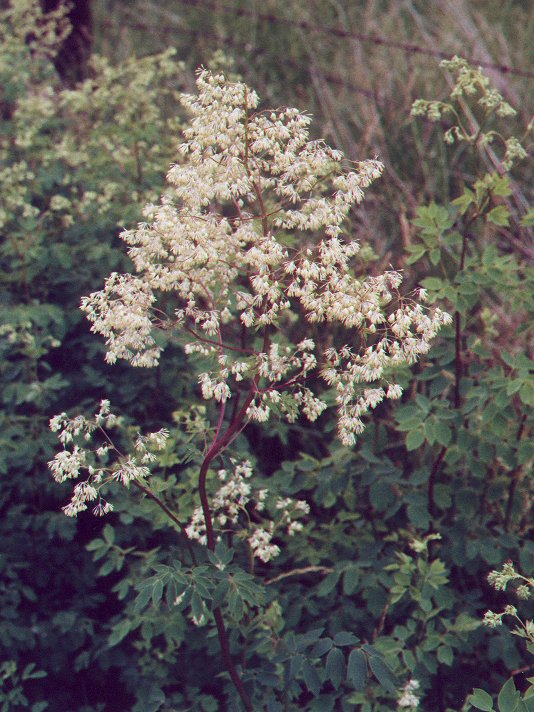Thalictrum dasycarpum Fisch. & Av-Lall.
Purple Meadow-Rue

Native
CC = 4
CW = -3
MOC = 54
© DETenaglia
Thalictrum dasycarpum Fisch. & Av-Lall.Purple Meadow-Rue | |
 |
Native CC = 4 CW = -3 MOC = 54 |
© DETenaglia |
|
Family - Ranunculaceae Stems - To 2m tall, erect, glabrous, purple, herbaceous, fistulose, from caudex, branching above or simple, typically single from base. Leaves - Lowest leaves petiolate, middle and upper leaves becoming sessile, all leaves ternately compound. Leaflets green, typically 3-lobed, typically longer than broad, glabrous to puberulent below, to 5cm long, 4cm broad. Lobes acute, sometimes divided. Margins sometimes slightly revolute.
Inflorescence - Plants dioecious. Staminate inflorescence a large open terminal panicle, very showy. Pedicels 5-6mm long, glabrous, each subtended by a small attenuate bract to 1.5mm long. Pistillate inflorescence paniculate, terminal, not showy. Peduncles to 5mm long, glabrous. Flowers - Staminate flowers apetalous. Sepals 4, white, elliptic-lanceolate, 3mm long, 1.7mm broad, glandular pubescent externally, glabrous internally, fugacious. Stamens +/-12 in number. Filaments white, slightly clavate, 4mm long, glabrous. Anthers yellow, 1.2mm long, -1mm broad, apiculate. Pistillate flowers with +/-10 carpels. Styles whitish at apex. Sepals green, +/-2mm long.
Flowering - May - July. Habitat - Low moist ground, ravines, streambanks, thickets, roadsides. Origin - Native to U.S. Other info. - This species is common throughout much of Missouri but appears to be mostly absent from the Ozark region. The staminate plants can be quite showy in flower but the pistillate plants are often overlooked. This species and another, T. revolutum DC., can be very difficult to distinguish from one another. A third species, T. diocum L., is easier to distinguish because it blooms in the spring and has middle and uper leaves which are long petiolate instead of sessile. Photographs taken off ?, 6-3-00. |